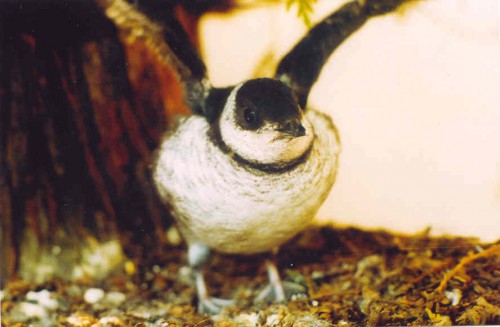Pursuing the Mystery of the Marbled Murrelet in the North Cascades

By Maria Mudd Ruth
Maria Mudd Ruth presents from her book Rare Bird: Pursuing the Mystery of the Marbled Murrelet at Village Books in Bellingham at 4 pm on Sunday, November 17, as part of our Nature of Writing Fall 2013 series.
William Leon Dawson (1873-1928), a well-respected naturalist, egg collector, and author was hot on the trail of the murrelet’s nest at the turn of the 19th century and wrote about his pursuits in his charming and authoritative book, The Birds of Washington, published in 1909.
Dawson was inclined to dismiss the Quileute Indian stories he had heard about murrelets nesting in trees in the Olympic Mountains, but that changed one morning when he was camping at Glacier “…on the North Fork of the Nooksak River, and near the foot of Mount Baker, having risen before daybreak for an early bird walk, on the morning of May 11, 1905, I heard voices form an invisible party of marbled murrelets high in the air as they proceeded down the valley, as tho to repair to the sea for the day’s fishing.” (Birds of Washington, p. 921-922)
Glacier is 24 miles inland from the nearest salt water. Dawson, like most naturalists and ornithologists at the time, could not accept the idea that a web-footed seabird would nest in trees in the forest–not to mention so far inland. Other birds in the alcid family to which murrelets belong nested on rocky cliffs, offshore islets, in burrows in coastal bluffs–not in the forest.
This inland sighting at Glacier, however, allowed Dawson to be open to the possibility of a forest-nesting seabird. Following his sightings at Glacier, Dawson documented sightings of murrelets in California alone and with Joseph Grinnell in the 1920s. Both these men documented their sightings and thereby left a paper trail that eventually lead to the first nest discovery in California’s Santa Cruz Mountains in 1974.
 A young murrelet about to fledge near the Snohomish River in western Washington. Photo by Tom Hamer.
A young murrelet about to fledge near the Snohomish River in western Washington. Photo by Tom Hamer.
In 1989, wildlife ecologist Tom Hamer was camping in Dawson’s stomping grounds in the North Cascades. Hamer had just finished nine years of spotted-owl research and was ready for a change. When he heard about a “strange creature” called the marbled murrelet, he wanted to see one. He joined some colleagues on a camping trip in the Mount Baker-Snoqualmie National Forest along the South Fork of the Nooksack River. On his first morning, he heard and saw birds flying up the river drainage. A year later, he was surveying murrelets in the forest here and, using his own invented strategy for finding murrelet nests, found first marbled murrelet nest in Washington.
With his characteristic enthusiasm, energy, and brilliance, Tom Hamer began collaborating with other biologists in the 1990s to develop nest-finding strategies so the breeding habits of the murrelet could be understood. Through the Pacific Seabird Group and now through his own consulting firm, Hamer Environmental (based Mt. Vernon WA), Hamer’s contribution to murrelet research is major, critical, and highly respected in the scientific community.
Excerpts from Maria Mudd Ruth’s Rare Bird: Pursuing the Mystery of the Marbled Murrelet (Reprinted by The Mountaineers Books, 2013), courtesy of the author.
Leading photo: ancient murrelet flicking tail up as it prepares to dive deep at the intersection of Bellingham and Guemes Channels near Anacortes. © 2013 Andrew A Reding.


Which species of murrelet would I have encountered on Cayuse Mtn. in Okanogan County approx 5000 feet elevation, ca. 9/5/2018? From descriptions, the marbled variety- but no other reports appear to place them so far from the coast. Only two seen, on open slope below stand of large ponderosa pines. None seen before nor since then.